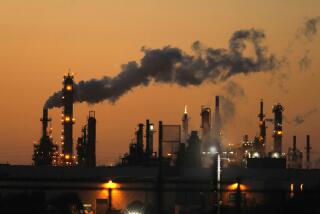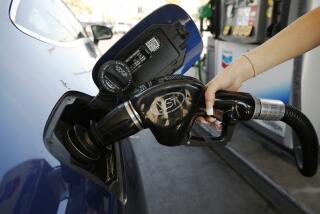Southland Gas Prices Rise Again
- Share via
The summer trend in Southern California gasoline prices has abruptly changed course, with both wholesale and pump prices climbing again just as consumers prepare to hit the road for the Labor Day weekend.
Small glitches at several California refineries in recent days, motorists’ continued strong demand for gasoline and a skittish trading market for fuel are combining to drive wholesale gasoline prices higher, and those gains are finding their way to the pump, oil executives and analysts said Monday.
Wholesale gasoline prices in the Los Angeles area have surged more than 30 cents a gallon in just the last two weeks, and the price was $1.18 a gallon Monday, said Bob van der Valk, manager of fuel supply and marketing at Cosby Oil Co., an independent fuel distributor based in Santa Fe Springs.
Less than a month ago, the wholesale price bottomed at 77.5 cents a gallon in the Los Angeles area, said Rob Schlichting, a spokesman for the California Energy Commission.
Dealers then add state and federal taxes, their operating costs and their profit margin to come up with the per-gallon pump price. And those prices, which dipped as low as $1.40 a gallon for self-serve regular at many Southern California stations a week ago, are again more than $1.50 or $1.60 a gallon.
For the entire state, the average price for self-serve regular edged up to $1.535 in the week ended Monday from $1.523 a week earlier, the U.S. Energy Department said.
The increase, the first in 11 weeks, came as 2.3 million Californians prepare to take trips by vehicle during this three-day weekend, about the same as a year ago, according to the Automobile Club of Southern California.
But the price spike could be short-lived. None of the problems at the refineries is expected to keep the plants shuttered for long. And traditionally gasoline prices fall along with drivers’ demand after the Labor Day holiday, analysts said.
“Everything is going upward because of Labor Day,” Van der Valk said. “So after the Labor Day weekend, then I see it [prices] coming back down unless there’s some unforeseen event.”
Refinery shutdowns are just the sort of unforeseen events that pose threats to California’s gasoline market, because the state’s supplies are normally tight. The full or partial shutdown of one refinery can briefly pull enough gasoline off the market to send prices higher.
That’s what happened after part of a big refinery in Carson owned by BP, the parent of Arco, was shut down May 26 because of mechanical problems. The incident briefly lifted prices on the spot, or current, market, but then prices quickly resumed their summer slide, and average pump prices for self-serve regular hit an 18-month low a week ago.
The situation here is exacerbated because the state requires a special, cleaner-burning gasoline that only a handful of out-of-state refineries can produce. Imports of gasoline from other parts of the country aren’t an option when shortages develop.
Until recently, gasoline supplies in the state had been ample--which is why pump prices tumbled all summer after surging above $2 a gallon in the spring. In the week ended Aug. 17, “production was healthy at more than 1 million barrels a day,” and gasoline supplies were 13% higher than a year earlier, Schlichting of the energy commission said.
But in the last two weeks, there have been problems at several California refineries, including Chevron Corp.’s plant in El Segundo and a refinery in Martinez in the Bay Area run by Equilon Enterprises, a joint venture of Texaco Inc. and Royal Dutch/Shell Group, said Cosby Oil’s Van der Valk.
Those setbacks probably have reduced supplies and, in some cases, forced the oil companies to buy gasoline on the spot market to maintain their daily output to dealers, he said.
In addition, Tosco Corp., which sells gasoline under the 76 brand, decided this year to directly tie the wholesale price it charges dealers to the spot price, which helps put upward pressure on pump prices industrywide when market prices for fuel start rising, analysts said.
Prices in California also are rising because of the psychological effect of surging gasoline prices elsewhere in the country, notably in the Midwest, they said. A recent fire at a Citgo Petroleum Corp. plant in Lemont, Ill., has disrupted supplies to the Chicago area; Citgo, a unit of Petroleos de Venezuela, said last week that it expects the refinery to remain closed for up to six months.
That outage helped send gasoline futures prices surging to a two-month high on the New York Mercantile Exchange late last week and again Monday. Gasoline for September delivery edged up 0.25 cent to 83.82 cents a gallon Monday.
At the same time, the average national price for self-serve regular gasoline rose to $1.488 a gallon in the week ended Monday, from $1.427 the prior week, the Energy Department said.
During the Labor Day weekend, wholesalers and retail dealers will simply take advantage of consumers’ heavy driving to turn a bigger profit by raising prices as much as possible, analysts said. Then prices typically head back down as available supplies go up.
Last year, for instance, self-serve regular averaged $1.79 a gallon over the Labor Day weekend, but by Christmas it was averaging $1.65 a gallon, according to the Energy Department.
More to Read
Inside the business of entertainment
The Wide Shot brings you news, analysis and insights on everything from streaming wars to production — and what it all means for the future.
You may occasionally receive promotional content from the Los Angeles Times.











